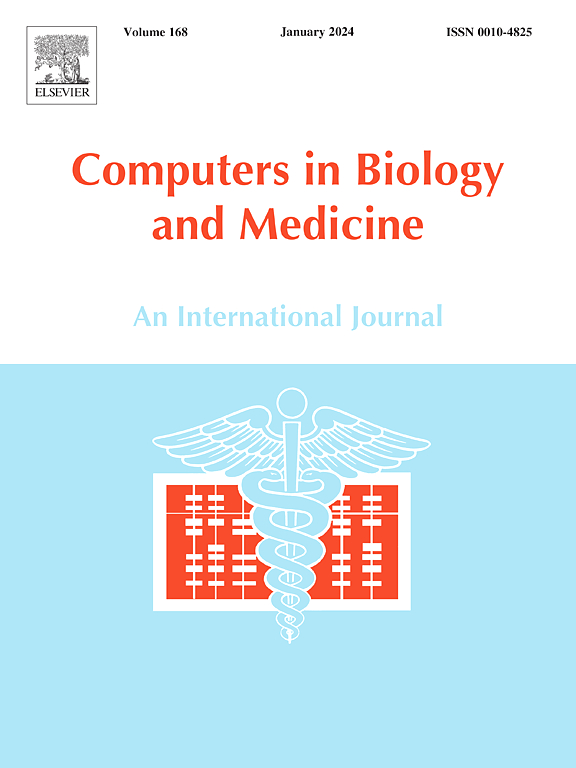MHS U-Net:用于医学图像分割的多尺度混合减法网络
IF 7
2区 医学
Q1 BIOLOGY
引用次数: 0
摘要
医学图像分割在现代临床诊断中起着至关重要的作用。然而,现有方法存在特征提取不足、空间建模能力有限、泛化能力有限、计算成本低等问题。为了解决这些问题,我们提出了一种用于医学图像分割的多尺度混合减法网络(MHS U-Net)。首先,将预训练好的PVTv2-B2作为编码器,增强模型对复杂多模态医学图像的适应性和特征提取能力;其次,在瓶颈处设计多层移位感知注意(Multi-Layer Shift Perception Attention, MSPA)机制,通过深化网络结构捕获细粒度的高级特征,同时有效抑制移位操作带来的计算成本激增。在解码器中,开发了一种多尺度混合卷积减解码器(Multi-Scale Hybrid Convolution Subtraction decoder, MSHCSD),通过整合群卷积、门控机制和深度卷积块,改进了病灶内部和周围空间关系的建模,显著增强了模型的泛化能力。此外,针对多尺度特征交互利用不足的问题,提出了一种多尺度减模(multi-scale Subtraction Module, MSSM),通过差分信息提取和互补特征增强加强跨尺度特征融合,从而实现病灶区域的精确定位和分割。在5种成像模式的14个公共数据集上的实验结果表明,MHS U-Net在指标和视觉结果方面始终优于最先进的方法。此外,MHS U-Net只需要5.48G FLOPs和11.59M参数,明显低于大多数现有型号。总体而言,MHS U-Net在多模态医学图像分割任务中提供了模型性能和尺寸之间的良好平衡。本文章由计算机程序翻译,如有差异,请以英文原文为准。
MHS U-Net: Multi-scale hybrid subtraction network for medical image segmentation
Medical image segmentation plays a critical role in modern clinical diagnosis. However, existing methods face challenges such as insufficient feature extraction, limited spatial modeling capabilities, and restricted generalization ability with low computational cost. To address these challenges, we propose a Multi-scale Hybrid Subtraction Network (MHS U-Net) for Medical Image Segmentation. First, a pretrained PVTv2-B2 is integrated as the encoder to enhance the model's adaptability and feature extraction capability for complex multi-modal medical images. Second, a Multi-Layer Shift Perception Attention (MSPA) mechanism is designed at the bottleneck to capture fine-grained high-level features by deepening the network structure, while effectively suppressing the surge in computational cost through shift operations. In the decoder, a Multi-Scale Hybrid Convolution Subtraction Decoder (MSHCSD) is developed, to improve the modeling of spatial relationships within and around lesions and significantly enhance the model's generalization ability through integrating group convolution, gating mechanisms, and deep convolutional blocks. Additionally, to address the insufficient utilization of multi-scale feature interactions, a Multi-Scale Subtraction Module (MSSM) is proposed to strengthen cross-scale feature fusion through differential information extraction and complementary feature enhancement, thereby achieving the precise localization and segmentation of lesion regions. Experimental results on 14 public datasets across five imaging modalities demonstrate that MHS U-Net consistently outperforms state-of-the-art methods in metrics and visual results. Moreover, MHS U-Net requires only 5.48G FLOPs and 11.59M parameters, significantly lower than most existing models. Overall, MHS U-Net offers an excellent balance between model performance and size in multi-modal medical image segmentation tasks.
求助全文
通过发布文献求助,成功后即可免费获取论文全文。
去求助
来源期刊

Computers in biology and medicine
工程技术-工程:生物医学
CiteScore
11.70
自引率
10.40%
发文量
1086
审稿时长
74 days
期刊介绍:
Computers in Biology and Medicine is an international forum for sharing groundbreaking advancements in the use of computers in bioscience and medicine. This journal serves as a medium for communicating essential research, instruction, ideas, and information regarding the rapidly evolving field of computer applications in these domains. By encouraging the exchange of knowledge, we aim to facilitate progress and innovation in the utilization of computers in biology and medicine.
 求助内容:
求助内容: 应助结果提醒方式:
应助结果提醒方式:


